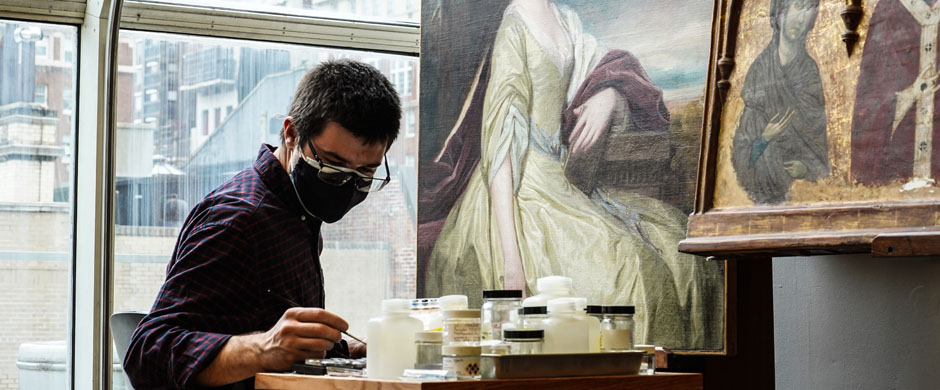 | IN THE LAB
| IN THE LAB

Paintings Conservation
The paintings curriculum allows students to pursue their interests in paintings from the Middle Ages to the present. Every paintings major takes at least one class in the Kress Program in Painting Conservation; additional courses expose students to topics including the structural treatment of paintings on canvas, advanced cleaning and inpainting techniques, and the conservation of modern and contemporary paintings and painted surfaces. The procedures learned depend to some degree on the particular artworks available and their conditions.
To provide training in the conservation of modern and contemporary paintings, courses have been developed that take advantage of the abundance of collections and resources in New York City. Students have treated pictures by artists including Yayoi Kusama, Andy Warhol, Joan Mitchell, Helen Frankenthaler, Will Barnet, Rammellzee, and Esteban Vicente. We are fortunate to have close connections with the Grey Art Gallery of NYU, which has works from the late-nineteenth through the twentieth centuries and is particularly strong in mid-twentieth century painting, as well as to the collections and professionals at MoMA, the Whitney, and the Guggenheim, and to private conservation practices in New York.
Students at the advanced level also have the opportunity to create their own individualized coursework. With the guidance of a supervising instructor and the approval of the Chair, students can work in other museums or private labs in the city, which can expose them to an even wider range of paintings and conservation problems. Students have also undertaken treatment and research on paintings at NYU’s Villa La Pietra.
Kress Program in Paintings Conservation
Kress Program in Paintings Conservation
With generous support from the Samuel H. Kress Foundation, the Kress Program in Painting Conservation offers unique and unparalleled training in the conservation of Old Master paintings. The Kress Program (as it is informally known) focuses on the cleaning, retouching, and technical analysis of selected works from the Samuel H. Kress Collection and forms the foundation for our paintings conservation program. Every student specializing in paintings conservation will take at least one class treating a Kress picture on panel or canvas during their studies.
Depending on the availability of projects and interest, students from other specialties may also enroll in a Kress Class. The collection includes over 1,000 European paintings dating from the thirteenth to the nineteenth centuries, held at more than 90 institutions in 33 states. Nowhere amongst U.S. conservation graduate programs can students learn from such a distinguished and unmatched collection of Old Master paintings. Dianne Dwyer Modestini, Clinical Professor Emerita for the Kress Paintings Program, Matthew Hayes, Assistant Professor of Paintings Conservation, and Molly Hughes-Hallett, Associate Conservator for the Samuel H. Kress Collection, provide the instruction in the treatment of these paintings. Generally, the paintings come to us from the collections of museums, regional galleries, or other institutions without resident conservation departments. Each picture is carefully selected for its suitability as a student project: the more advanced the student, the more challenging the conservation problems the pictures present. Students carry out a thorough examination and technical analysis of each painting over the course of its treatment. Paintings with more complicated needs are worked on by the instructors and serve as additional demonstrations of how to formulate and execute particularly demanding treatments. The close proximity and active interest of conservators and art historians from the Institute of Fine Arts, the Metropolitan Museum of Art, and other institutions nationwide enhances and informs the projects, providing new information about attribution, workshop practice, painting technique, original display, and later alterations. Over 250 Kress Collection paintings have been examined or treated at the Center since the inception of the pilot program in 1989.
The Kress Program in Paintings Conservation has also supported publications in the history, technology, and conservation of Italian paintings.